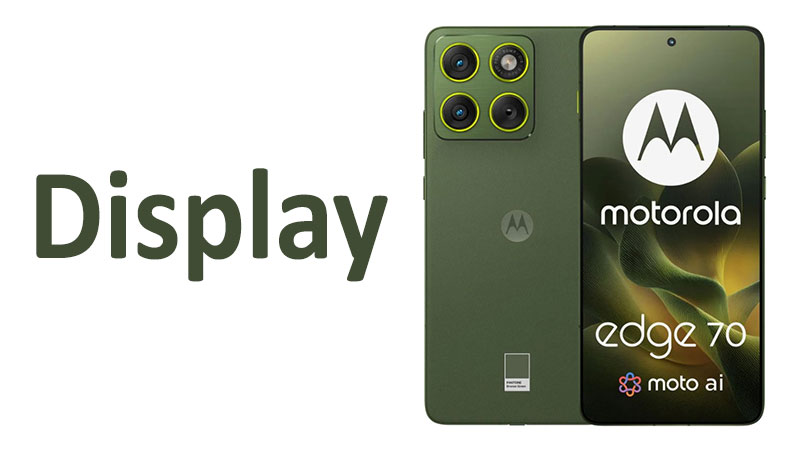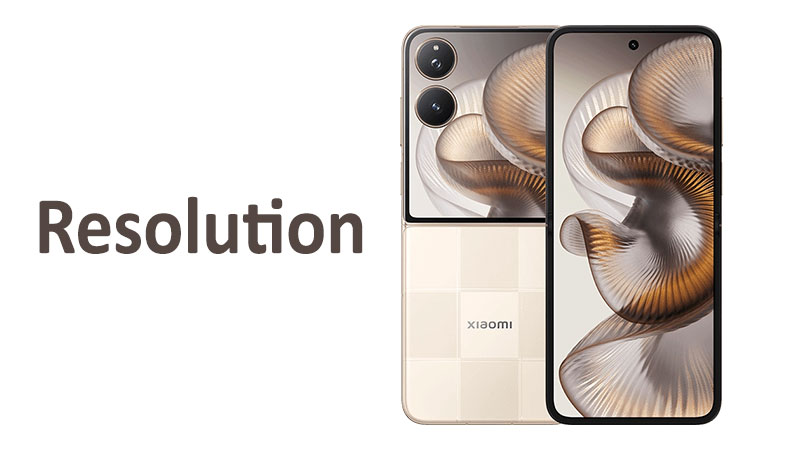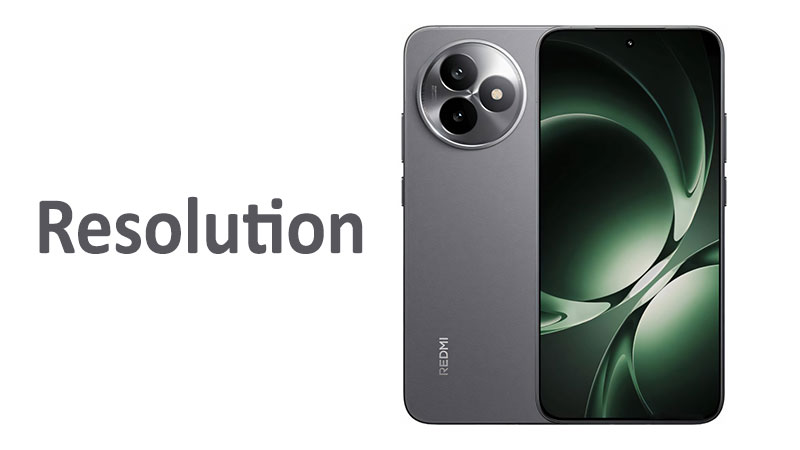The Motorola Edge 70 Display represents a significant advancement in mobile visual technology. This crucial screen component directly impacts the user’s daily experience. A high-quality screen is essential for everything, from browsing the web to consuming high-resolution media. This comprehensive review will thoroughly analyze the complete specifications and overall quality of the Motorola Edge 70 display. We investigate its cutting-edge P-OLED panel, its resolution, and its extreme peak brightness. Consumers can use this detailed examination to understand the phone’s visual power. We explore how its features deliver a premium, fluid experience for every user.
Detailed Display Technology Review
The Motorola Edge 70 utilizes a powerful collection of display technologies. These components are strategically chosen to maximize efficiency, color accuracy, and overall responsiveness. Understanding these core specifications is key to unlocking the phone’s full visual potential. We break down each major element systematically. This thorough analysis provides clarity for both technical and general audiences.
P-OLED Panel and Core Technology
The Motorola Edge 70 features an advanced P-OLED panel. P-OLED stands for Plastic Organic Light-Emitting Diode. This technology is a form of OLED where the substrate is flexible plastic instead of glass. The flexible nature allows for the slightly curved design often associated with the Edge series.
Advantages of P-OLED
P-OLED panels offer several key advantages. Like all OLED screens, each pixel is self-emissive. This means that when a pixel displays black, it is entirely switched off. The result is a perfect, true black color and an infinite contrast ratio. This capability gives images a stunning depth and realism that LCD screens simply cannot match. P-OLED panels also tend to be lighter and more resilient than glass-based AMOLED alternatives. They facilitate the sleek, thin design of the phone.
1 Billion Colors for Accuracy
The display is rated to support 1 Billion Colors. This specification refers to the panel’s 10-bit color depth capability. A standard 8-bit display only handles about 16.7 million colors. The massive leap to a billion colors is crucial for high-fidelity content. It allows for incredibly smooth color transitions and eliminates color banding. This is especially noticeable when viewing difficult gradients, like sunsets or underwater scenes.
Comparison to Competitor AMOLED
The P-OLED used here is comparable to the AMOLED used by many competitors. Functionally, both deliver perfect blacks and excellent viewing angles. However, P-OLED often allows manufacturers to create lighter and thinner devices. It also supports the distinctive curved screen aesthetic. This flexible base provides a subtle ergonomic benefit when handling the phone. Buyers should understand that P-OLED is a high-end choice equivalent to the best OLED panels available.
Pros and Cons of P-OLED
A key pro is the superior contrast, resulting in perfect blacks. Another benefit is the panel’s contribution to the phone’s overall lightweight design. A potential con is that the plastic substrate may be slightly less scratch-resistant than glass-based screens. Therefore, using the included screen protection is highly advisable. The visual benefits significantly outweigh this minor physical concern.
Resolution and Clarity Performance
The Motorola Edge 70 boasts a resolution of 1220 x 2712 pixels. This density is a significant upgrade from the traditional Full HD+ standard. It ensures that the display delivers exceptional clarity and sharpness for all content. This specific resolution choice is aimed at providing maximum detail and efficiency.
Pixel Per Inch Density Analysis
This resolution results in an excellent pixel density of approximately 446 pixels per inch (ppi). At 446 ppi, the visual quality is superb. Individual pixels become practically invisible to the human eye at a normal viewing distance. All text appears incredibly smooth, crisp, and easy to read. This high clarity is essential for a comfortable and immersive mobile experience, especially when reading small text.
The 1.2K Resolution Standard
The 1220 x 2712 pixel count is sometimes referred to as a 1.2K resolution. It sits strategically between the common 1080p and the more demanding 1440p standards. This sweet spot offers a massive leap in visual detail over 1080p. Simultaneously, it avoids the significant power consumption of a full 1440p Quad HD+ display. Motorola made a wise engineering choice here. They prioritized visual fidelity while maintaining excellent battery efficiency for the user.
Comparison to Previous Models
Previous Motorola Edge models sometimes used standard 1080p resolution. The increase to 1.2K in the Edge 70 is a clear upgrade. This superior resolution delivers noticeably finer details in photographs and videos. It significantly enhances the premium feel of the overall visual experience. Buyers can expect sharper edges and smoother lines across the entire interface.
Clarity Pros and Cons
The primary pro is the outstanding sharpness delivered by the 446 ppi density. This ensures a fatigue-free and crystal-clear reading environment. A minor con is that the unique 1.2K resolution is non-standard. This means some older apps or content might require minor scaling, although this is usually handled seamlessly by the operating system. The overall clarity is a defining feature of this display.
Size, Aspect Ratio, and Aesthetics
The Motorola Edge 70 features a large 6.7-inch display. This generous size provides an expansive and highly immersive viewing surface for modern applications. The calculated screen area is approximately 107.4 cm². This dimension makes the phone ideal for all types of multimedia consumption.
Screen-to-Body Ratio
The device achieves an excellent screen-to-body ratio of around 90.4%. This high ratio signifies that the screen bezels are extremely minimal. Thin bezels are a hallmark of a modern flagship design. They maximize the usable display area, contributing to the edge-to-edge viewing experience. This sleek design makes the screen feel even larger than its measured size.
Aspect Ratio for Content
The display uses a 20:9 aspect ratio. This is a tall, narrow shape that is becoming standard in modern smartphones. This ratio is beneficial for social media feeds and web browsing. It allows more content to be displayed vertically before the user needs to scroll. It also aligns well with cinematic movie formats, minimizing black bars during video playback.
Buyer Information on Size
The 6.7-inch size is considered the optimal large-screen format by many users. It is perfect for gaming, video streaming, and document viewing. Users who prefer a truly immersive experience will appreciate this size. However, users with smaller hands may find that one-handed operation can be challenging. The curved P-OLED edges do assist in maintaining a comfortable grip, despite the phone’s overall size.
Ultra-High Brightness and HDR Capability
The Motorola Edge 70 screen is engineered for extreme brightness performance. It is capable of reaching a spectacular peak brightness of 4500 nits. This extreme level of luminance is one of the highest specifications in the current smartphone market. This massive output is essential for high-quality HDR rendering.
4500 Nits Peak Brightness Explained
It is important for buyers to understand how peak brightness works. The full 4500 nits is not used for the entire screen at once. It is reserved for small areas, or highlights, when displaying High Dynamic Range (HDR) content. This extreme luminance creates a striking contrast. The brightest parts of a video, such as sunlight or reflections, appear incredibly vivid and lifelike. This elevates the standard for mobile movie viewing.
Real-World Brightness (Typical and HBM)
While the typical brightness is not explicitly listed, we can infer its capability. Given the 4500 nits peak, the typical High Brightness Mode (HBM) for outdoor use will be competitive. HBM engages automatically in direct sunlight. It allows the screen to overpower harsh ambient light, maintaining excellent readability outdoors. This strong performance ensures the phone is usable under any bright condition.
HDR10+ Certification
The display is certified for HDR10+ support. HDR10+ is an advanced HDR standard that uses dynamic metadata. This metadata allows the image quality to be optimized frame-by-frame or scene-by-scene. The phone can adjust brightness and color settings based on the specific content being played. This dynamic optimization provides a superior visual experience compared to static HDR formats.
Comparison to Competitors
The 4500 nits peak brightness places the Motorola Edge 70 among the industry leaders. It significantly surpasses many rivals that max out in the 2000-3000 nit range. This specification ensures that the phone is perfectly future-proofed for the most demanding HDR content. For users prioritizing media quality, this high brightness is a compelling feature. The resulting images are incredibly vibrant and realistic.
Refresh Rate and Motion Fluidity
The Motorola Edge 70 is equipped with a smooth 120Hz refresh rate. This means the screen updates the displayed image 120 times every second. A high refresh rate is now a crucial feature for any premium smartphone experience. It fundamentally changes how the user interacts with the device.
Impact on Interaction and Gaming
The 120Hz rate transforms scrolling from choppy to buttery smooth. Navigating the operating system feels instantaneous and highly responsive. Moving between applications is seamless, providing a sense of speed and fluidity. Gamers gain a competitive edge due to reduced motion blur and faster visual feedback. The high refresh rate makes all content look more lifelike and engaging.
The PWM Dimming System
The display uses a PWM (Pulse Width Modulation) dimming system. This technique manages screen brightness at low light levels. The exact frequency is not specified, but PWM in OLEDs can sometimes lead to flicker. This flicker can cause eye strain for sensitive users. Motorola needs to ensure that the PWM frequency is sufficiently high to mitigate this potential issue. An ultra-high frequency is key for comfortable late-night viewing.
Buyer Note on Refresh Rate
The 120Hz refresh rate should always be enabled in the settings for the best user experience. Sometimes phones default to a lower 60Hz rate to save battery power. Users must ensure they are enjoying the maximum fluidity this premium panel offers. The 120Hz motion is one of the most noticeable daily improvements over older phones.
Comparison to Adaptive Systems
The Motorola Edge 70 uses a high 120Hz rate but does not specify an LTPO panel. LTPO panels can adapt down to 1Hz for ultimate efficiency. This means the Edge 70’s 120Hz is likely stepped, toggling between 60Hz and 120Hz. While slightly less efficient than full LTPO, a dedicated 120Hz mode still delivers excellent, consistent performance. The power management is handled through software optimization rather than the panel’s physical composition.
Protection: Corning Gorilla Glass 7i
The display is protected by Corning Gorilla Glass 7i. This specific glass variant is engineered for superior durability and resilience. Protection is a critical factor for a large, edge-to-edge display like the Edge 70’s. This material safeguards the visual quality against physical damage.
Understanding Gorilla Glass 7i
The “i” in 7i typically signifies a variant optimized for thinness and impact resistance. It provides excellent defense against the minor accidents of daily life. This includes resistance to scratches from coins or keys in a pocket. It also offers crucial protection against shattering when the phone is accidentally dropped. The strength of the protective glass is directly related to the longevity of the device.
Durability and Longevity
The robust protection provided by Gorilla Glass 7i is essential. High replacement costs are common for flagship screens. Relying on a durable glass layer reduces the likelihood of expensive repairs. This peace of mind is a valuable component of the overall phone experience. This is a necessary feature for a premium device designed for long-term use.
Buyer Considerations for Protection
Despite the advanced Gorilla Glass 7i, users should still consider an external screen protector and a protective case. No glass is completely unbreakable under all circumstances. Adding these layers of defense further maximizes the phone’s resistance to physical damage. The integrated Gorilla Glass layer provides a strong, reliable foundation for daily handling.
The Real-World Viewing Experience
The combined effect of these high-end specifications creates an outstanding visual experience. The P-OLED panel ensures rich, perfect colors and unparalleled contrast. The 1.2K resolution maintains sharp detail for all imagery and text. The 120Hz refresh rate makes every interaction fluid and smooth. Finally, the 4500 nits peak brightness transforms HDR video into a cinematic event.
Media Consumption
For users who consume a lot of video content, the display is exceptional. The HDR10+ support combined with the extreme brightness maximizes picture quality on streaming platforms. Movies and shows look punchy, dynamic, and incredibly detailed. The large 6.7-inch size contributes significantly to the immersive viewing environment.
Gaming Performance
The 120Hz refresh rate is a massive advantage for mobile gamers. The low latency and reduced motion blur provide a competitive edge in fast-paced titles. The vibrant colors and high resolution make game worlds look graphically stunning. The phone’s display quality is perfectly matched to the performance demands of modern mobile gaming.
User Comfort
The P-OLED technology generally offers wide viewing angles. This ensures that colors and brightness remain consistent even when the phone is viewed off-axis. The high resolution prevents eye strain when reading extended articles or books. The overall visual presentation is comfortable, clear, and engaging for long periods of use.
Summarized Pros and Cons for Buyers
The Motorola Edge 70 display offers several highly attractive features for consumers. Reviewing the summarized advantages and disadvantages aids in making a final purchasing decision. We analyze the strengths and weaknesses of the key display components.
Key Display Pros
The exceptional 4500 nits peak brightness is a class-leading feature for HDR content. The P-OLED panel provides perfect blacks and infinite contrast ratios. Excellent 10-bit color depth ensures seamless gradients and accurate color reproduction. The 120Hz refresh rate delivers silky smooth scrolling and responsive gaming performance. The 1.2K resolution offers superior sharpness compared to standard 1080p displays. Finally, the Corning Gorilla Glass 7i provides robust and reliable screen protection.
Key Display Cons
The display does not feature a specified ultra-high PWM dimming frequency. This might concern users who are extremely sensitive to screen flicker at low brightness. The large 6.7-inch size may be cumbersome for users who prefer compact devices. The absence of LTPO technology means the adaptive refresh rate is likely less battery efficient than some competitor screens. The typical brightness level is not specified, making direct comparisons difficult.
Conclusion: Making an Informed Choice
The Motorola Edge 70 display is clearly a high-performance panel designed for premium content consumption. It combines best-in-class components to deliver a stunning visual experience. The 4500 nits peak brightness and HDR10+ support make it a fantastic device for watching movies. The 120Hz fluidity and P-OLED clarity ensure a responsive and beautiful daily interaction. While it lacks LTPO, the 1.2K resolution and superior brightness compensate effectively. Consumers prioritizing an exceptionally bright, colorful, and large screen will find the Motorola Edge 70 display to be a compelling choice. This phone offers a truly flagship-level viewing platform.
Frequently Asked Questions (FAQ)
1. Does the Motorola Edge 70 use an LTPO display?
No, the Motorola Edge 70 features a P-OLED panel. This screen is not LTPO. It primarily toggles between standard refresh rates like 60Hz and 120Hz for motion fluidity.
2. How is P-OLED different from standard AMOLED?
P-OLED uses a flexible plastic substrate instead of glass. This makes the screen lighter and more durable. It allows for the subtle curves often used in the phone’s design.
3. Is the 4500 nits brightness used all the time?
No, 4500 nits is the peak brightness. The screen uses this high level only in small areas for High Dynamic Range (HDR) content. It ensures dazzling highlights in supported videos.
4. What is the screen resolution and pixel density?
The display resolution is 1220 x 2712 pixels. This results in an excellent pixel density of approximately 446 ppi. This density ensures all images and text are crystal clear.
5. What kind of glass protects the display?
The Motorola Edge 70 display is protected by Corning Gorilla Glass 7i. This is a specialized, durable glass designed to offer strong resistance against scratches and impacts.



